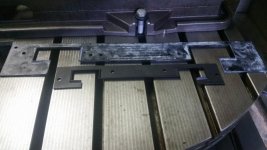sneebot
Stainless
- Joined
- May 14, 2001
- Location
- Massachusetts
A bought this FP4 some years ago and wanted to install a DRO on it. Looking at most of the FP4 DRO retrofit images on the web they generally look like a mess with cables all over the place. I wanted a cleaner installation more like the FP3 DRO retrofit I did here: http://www.practicalmachinist.com/vb/deckel-maho-aciera-abene-mills/fp3-dro-install-167732/
(Although it looks like the images may have disappeared)
I machined a similar arm for the DRO box (a used Positip 880). The FP3 had a factory installed mounting point for the DRO arm whereas the FP4 did not. Removing the operators side panel (a hefty cast iron piece) I milled this out on the CNC to allow for mounting of the ‘knuckle’ joint for the DRO arm. This knuckle allowed me to route all the scale cables into the machine itself to produce a much cleaner install.



(Although it looks like the images may have disappeared)
I machined a similar arm for the DRO box (a used Positip 880). The FP3 had a factory installed mounting point for the DRO arm whereas the FP4 did not. Removing the operators side panel (a hefty cast iron piece) I milled this out on the CNC to allow for mounting of the ‘knuckle’ joint for the DRO arm. This knuckle allowed me to route all the scale cables into the machine itself to produce a much cleaner install.










